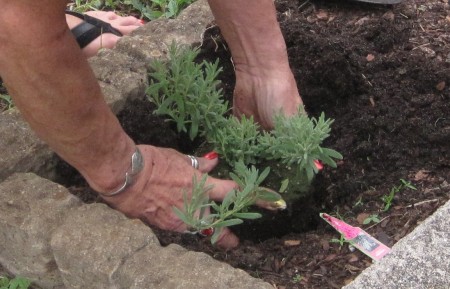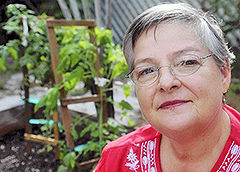Time to Plant
It is October in Florida, and that means the solarization covers on the garden boxes come off and the prep work for the winter season begins.
 Removing Solarization Plastic Sheeting
Removing Solarization Plastic Sheeting
Once the plastic is removed, fertilizer is added to the soil and is raked in to a depth of four to six inches. I use Jobes Organics Vegetable & Tomato fertilizer. It is organic, easy to use, water soluble and it does not burn the plants if the directions are followed. Then, the soil is leveled and watered thoroughly.
Seedlings or Seed?
I use seed for okra, lettuce, spinach, cilantro, arugula and green beans. Everything else is a seedling. I have grown small yellow pear tomatoes from seed previously, but this year, I was able to get them already started.
So far, Neighbor Bill (Jacqie) Jackson, my garden partner, and I have planted lettuce, spinach, rosemary, cilantro, five varieties of tomatoes, two types of eggplant, green beans and poblano peppers. We will add okra from seed and jalapenos and pepperoncini pepper plants this weekend.
Perennial Herbs
Most of the herbs in the garden box are perennials, so they do not have to be removed and replanted. Cilantro is an exception. I plant that fresh several times a year. I use a lot of cilantro.
The herb box stays green and provides wonderful flavors for cooking all year. Soon, many other things will be sprouting green. Stay tuned for the winter season.
Tags: above ground garden · arugula · Cilantro · eggplant · Green Beans · jalapeno · Jobes feritlizer · lettuce · Okra · Raised Garden · rosemary · soil solarization · spinach · Tomatoes · Vegetables3 Comments




It’s so much fun to read your blog and I learn so much from you!
But I was wondering, if you plant seeds and seedlings now, when do you start harvesting?
Thank you for the kind words.
Most of my herbs are perennials that do not have to be replaced. Cilantro is an exception. Because I use so much of it, I plant cilantro seed every two weeks to keep a ready supply. (I do the same thing with lettuce and spinach.) Also, I start new basil, because it gets woody and the leaves get tough.
The plants going in the ground now… green beans, lettuce, spinach, etc… are ones that prefer cooler weather. What is planted in October can be harvested as quickly as November for lettuce and spinach, and as late as February for almost everything else. Some plants, like jalapeno peppers and tomatoes, may last into the summer.
The plants that are finished producing by February… green beans, for instance… will be pulled up and other vegetables will be planted in late February and early March.
The second planting will last until about mid July. At that time, everything will be pulled up and the summer solarization of the garden will begin. You can read about solarization here: http://www.watchmyfoodgrow.com/backyard-garden/soil-solarization-for-raised-gardens.
[…] has been about a month since the plastic was pulled off the garden boxes, and they were fertilized, raked level and watered. Right after, seeds were planted at various […]